Home / Rearrangements in Alkene Addition Reactions
Alkene Reactions
Rearrangements in Alkene Addition Reactions
Last updated: October 16th, 2024 |
Carbocation Rearrangements In Alkene Addition Reactions
- Alkene addition reactions that go through carbocation intermediates (such as addition of HCl, HBr, HI and H3O+) may occur with rearrangement of the carbocation intermediate if a more stable carbocation can be formed.
- Recall that carbocation stability increases with substitution, so tertiary carbocations are more stable than secondary carbocations, which are in turn more stable than primary carbocations.
- Rearrangements take the form of hydride shifts where a hydrogen atom and its pair of electrons migrates from an adjacent carbon, resulting in a more stable carbocation, or alkyl shifts where an alkyl group migrates with its pair of electrons.
- In certain cases, ring expansion reactions may also occur, where formation of a more stable carbocation is accompanied by release of ring strain from a small ring (e.g. cyclobutane)
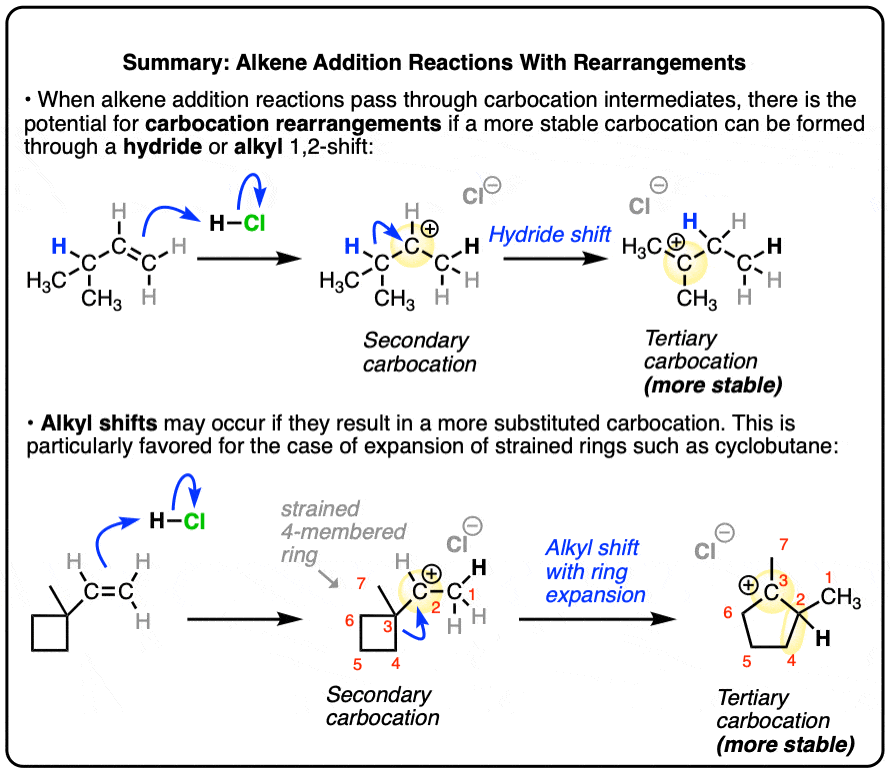
Table of Contents
- An Alkene Addition Reaction With A Twist
- Hydride Shifts In Alkene Additions, Step 1: Attack Of Acid By The Nucleophile
- The Key Rearrangement Step: Hydride Shift
- Step Three: Attack Of Nucleophile On The Carbocation
- Alkene Addition Reactions With Alkyl Shifts
- Alkene Addition Reactions With Ring Expansion
- Notes
- (Advanced) References and Further Reading
1. An Addition With A Twist
In exploring reactions that proceed along the carbocation pathway, every once in awhile you might see an example of an addition reaction that looks a little… strange. The alkene is gone, two new bonds have formed, but the positions of the new bonds is a little out of the ordinary. Like in this example!

If you tally up the bonds that form and the bonds that break, we notice that there is an extra set of C-H bond forming/breaking events.
If you’ve seen the previous articles in the substitution and elimination series, this should look familiar. It’s a telltale sign that a rearrangement has taken place.
2. Hydride Shifts In Alkene Additions, Step 1: Attack Of Acid By The Nucleophile
The first step in this reaction we’ve seen before: attack of the alkene upon the electrophile (in this case, the H of H-Cl). The result is a carbocation.
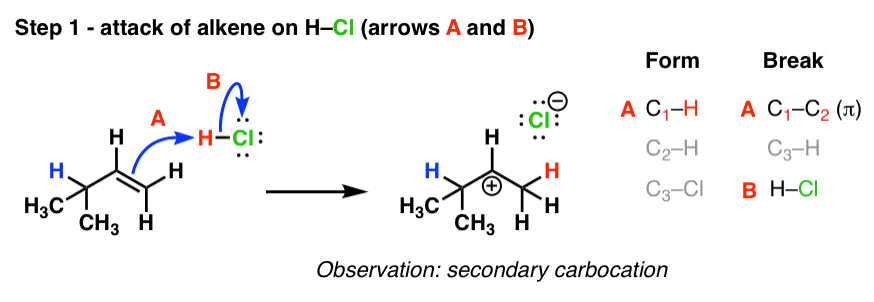
Note that the carbocation that’s been formed is a secondary carbocation, and it’s adjacent to a tertiary carbon.
3. The Key Rearrangement Step: Hydride Shift
In this next step, the lone pair in the C-H bond migrates from the tertiary carbon to the secondary, forming a new (tertiary) carbocation. The driving force for this reaction is formation of the more stable carbocation.
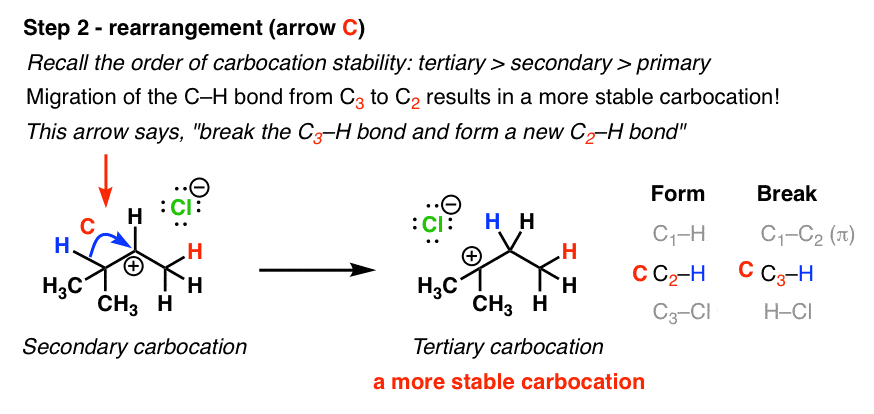
Note how it’s just one arrow we’re drawing here! The same arrow shows C-H bond breakage and C-H bond forming.
4. Step Three: Attack Of Nucleophile On The Carbocation
We’ve also seen the third step before. Attack of the nucleophile (chloride ion) upon the new carbocation gives us our new alkyl halide!

5. Alkene Addition Reactions With Alkyl Shifts
Rearrangements can also occur with alkyl shifts, as seen in the example below. Note again that the rearrangement step is represented by just one curved arrow!
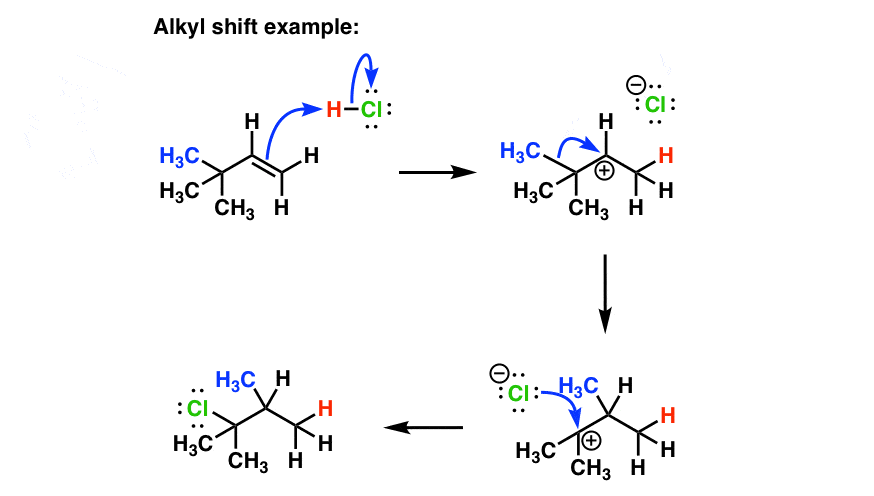
6. Alkene Addition Reactions With Ring Expansion
Finally, one of the cases that students often find very difficult is in recognizing reactions that occur with rings (ring expansion or ring contraction). Although perhaps difficult to see, in fact it proceeds through exactly the same mechanism as in the cases above. Note again that we’re depicting the rearrangement reaction with a single curved arrow. [Hint – if you’re doing this on your own, it might help to draw the ugly version first].
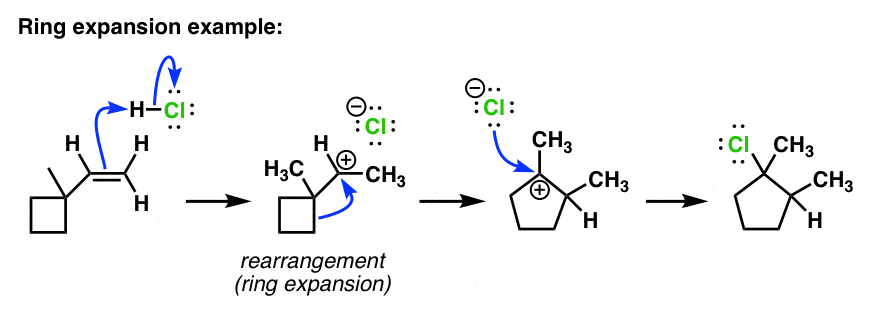
So why is it that the carbon from the ring migrates, and not the CH3 as before? A fair question. Migration of the CH3 would indeed produce a tertiary carbocation. However, migration of the CH2 from the ring not only produces a tertiary carbon but incrases the size of the ring from 4-membered to 5-membered, which relieves considerable ring strain present in the cyclobutane ring (worth about 26 kcal/mol).
That about does it for the carbocation pathway of alkene addition reactions. In the next post we’ll go into the second (of three) major pathways for alkene addition mechanisms.
NEXT POST: Bromination of Alkenes – How Does It Work?
Notes
Related Articles
- Bromination of Alkenes
- 3 Factors That Stabilize Carbocations
- Rearrangement Reactions (1) – Hydride Shifts
- Carbocation Rearrangement Reactions (2) – Alkyl Shifts
- Alkene Addition Pattern #2: The “Three-Membered Ring” Pathway
- Alkene Addition Pattern #3: The “Concerted” Pathway
- Pinacol Rearrangement (MOC Membership)
- Additions to alkenes accompanied by 1,2-hydride shifts (MOC Membership)
- Acid-Catalyzed Addition of H2O To Alkenes
(Advanced) References and Further Reading
- Ueber die Beziehung der Pinenhaloïdhydrate zu den Haloïdanhydriden des Borneols
Georg Wagner, W. Brickner
Ber. 1899, 32 (2), 2302-2325
DOI: 10.1002/cber.189903202168
The oldest examples of these rearrangements are in the pinene series. Wagner showed these rearrangements occur in conversions of pinene to bornyl compounds. - Über die Gleichgewichts‐Isomerie zwischen Bornylchlorid, Isobornylchlorid und Camphen‐chlorhydrat
Hans Meerwein and Konrad van Emster
Ber. 1922, 55 (8), 2500-2528
DOI: 10.1002/cber.19220550829
Prof. Hans Meerwein extended Wagner’s work to non-terpene series, and came up with the crucial insight that it proceeded through a carbonium ion – a very controversial insight at the time! Crucial experiment was finding rate was dependent on solvent polarity. Rate order was SO2 > MeNO2 > MeCN > PhNO2 > PhCN > PhOMe > PhBr > EtBr > PhCl > C6H6 > pet ether > ether. Furthermore, he found that certain acids considerably accelerated the rearrangement of camphene hydrochloride to isobornyl chloride. Alkyl migrations in carbocations are often called “Wagner-Meerwein” rearrangements after Georg Wagner and Prof. Hans Meerwein, who studied them more rigorously. - Mechanism of substitution at a saturated carbon atom. Part XXXII. The rôle of steric hindrance. (Section G) magnitude of steric effects, range of occurrence of steric and polar effects, and place of the Wagner Rearrangement in nucleophilic substitution and elimination
I. Dostrovsky, E. D. Hughes, and C. K. Ingold
J. Chem. Soc. 1946, 173-194
DOI: 10.1039/JR9460000173
Prof. Ingold formalized rules for carbocations:
1) It is necessary for rearrangement that initial bond breakage result in an atom with an incomplete octet
2) The system will only rearrange if the free energy change is in the right direction (i.e. the carbocation being rearranged to should be more stable, e.g. secondary -> tertiary).
This tied together SN1, E1, alkene addition with Wagner-Meerwein shifts in a unified framework. - Communications TO THE EDITOR
The Journal of Organic Chemistry 1962, 27 (5), 1926-1932
DOI: 10.1021/jo01052a098
Rigid steroid and diterpenoid systems show addition reactions where multiple hydride and alkyl shifts can occur. One example is dihydroipimaric acid. - The constitution and stereochemistry of euphol
H. R. Barton, J. F. McGhie, M. K. Pradhan, and S. A. Knight
J. Chem. Soc. 1955, 876-886
DOI: 10.1039/JR9550000876
Euphenol, which is similar to lanosterol, also undergoes addition via a carbocation intermediate which can undergo successive hydride and alkyl shifts. - The Structures of the Triterpenes Friedelin and Cerin
E. J. Corey and J. J. Ursprung
Journal of the American Chemical Society 1956, 78 (19), 5041-5051
DOI: 10.1021/ja01600a064
The path from Friedelin to Cerin is a crazy series of fun rearrangements! - Total synthesis of (±)-isocomene and related studies
Michael C. Pirrung
Journal of the American Chemical Society 1981, 103 (1), 82-87
DOI: 1021/ja00391a016
The rearrangement of vinyl cyclobutane opening to cyclopentane is accompanied by relief of ring strain, and this paper shows that can be applied fruitfully in sesquiterpene synthesis. - The Addition of Hydrogen Bromide to Simple Alkenes
Hilton M. Weiss
Journal of Chemical Education 1995, 72 (9), 848
DOI: 1021/ed072p848
A simple experiment suitable for undergraduate organic chemistry laboratory courses that demonstrates that it is possible for the intermediate carbocation to rearrange and give different products.
00 General Chemistry Review
01 Bonding, Structure, and Resonance
- How Do We Know Methane (CH4) Is Tetrahedral?
- Hybrid Orbitals and Hybridization
- How To Determine Hybridization: A Shortcut
- Orbital Hybridization And Bond Strengths
- Sigma bonds come in six varieties: Pi bonds come in one
- A Key Skill: How to Calculate Formal Charge
- The Four Intermolecular Forces and How They Affect Boiling Points
- 3 Trends That Affect Boiling Points
- How To Use Electronegativity To Determine Electron Density (and why NOT to trust formal charge)
- Introduction to Resonance
- How To Use Curved Arrows To Interchange Resonance Forms
- Evaluating Resonance Forms (1) - The Rule of Least Charges
- How To Find The Best Resonance Structure By Applying Electronegativity
- Evaluating Resonance Structures With Negative Charges
- Evaluating Resonance Structures With Positive Charge
- Exploring Resonance: Pi-Donation
- Exploring Resonance: Pi-acceptors
- In Summary: Evaluating Resonance Structures
- Drawing Resonance Structures: 3 Common Mistakes To Avoid
- How to apply electronegativity and resonance to understand reactivity
- Bond Hybridization Practice
- Structure and Bonding Practice Quizzes
- Resonance Structures Practice
02 Acid Base Reactions
- Introduction to Acid-Base Reactions
- Acid Base Reactions In Organic Chemistry
- The Stronger The Acid, The Weaker The Conjugate Base
- Walkthrough of Acid-Base Reactions (3) - Acidity Trends
- Five Key Factors That Influence Acidity
- Acid-Base Reactions: Introducing Ka and pKa
- How to Use a pKa Table
- The pKa Table Is Your Friend
- A Handy Rule of Thumb for Acid-Base Reactions
- Acid Base Reactions Are Fast
- pKa Values Span 60 Orders Of Magnitude
- How Protonation and Deprotonation Affect Reactivity
- Acid Base Practice Problems
03 Alkanes and Nomenclature
- Meet the (Most Important) Functional Groups
- Condensed Formulas: Deciphering What the Brackets Mean
- Hidden Hydrogens, Hidden Lone Pairs, Hidden Counterions
- Don't Be Futyl, Learn The Butyls
- Primary, Secondary, Tertiary, Quaternary In Organic Chemistry
- Branching, and Its Affect On Melting and Boiling Points
- The Many, Many Ways of Drawing Butane
- Wedge And Dash Convention For Tetrahedral Carbon
- Common Mistakes in Organic Chemistry: Pentavalent Carbon
- Table of Functional Group Priorities for Nomenclature
- Summary Sheet - Alkane Nomenclature
- Organic Chemistry IUPAC Nomenclature Demystified With A Simple Puzzle Piece Approach
- Boiling Point Quizzes
- Organic Chemistry Nomenclature Quizzes
04 Conformations and Cycloalkanes
- Staggered vs Eclipsed Conformations of Ethane
- Conformational Isomers of Propane
- Newman Projection of Butane (and Gauche Conformation)
- Introduction to Cycloalkanes
- Geometric Isomers In Small Rings: Cis And Trans Cycloalkanes
- Calculation of Ring Strain In Cycloalkanes
- Cycloalkanes - Ring Strain In Cyclopropane And Cyclobutane
- Cyclohexane Conformations
- Cyclohexane Chair Conformation: An Aerial Tour
- How To Draw The Cyclohexane Chair Conformation
- The Cyclohexane Chair Flip
- The Cyclohexane Chair Flip - Energy Diagram
- Substituted Cyclohexanes - Axial vs Equatorial
- Ranking The Bulkiness Of Substituents On Cyclohexanes: "A-Values"
- Cyclohexane Chair Conformation Stability: Which One Is Lower Energy?
- Fused Rings - Cis-Decalin and Trans-Decalin
- Naming Bicyclic Compounds - Fused, Bridged, and Spiro
- Bredt's Rule (And Summary of Cycloalkanes)
- Newman Projection Practice
- Cycloalkanes Practice Problems
05 A Primer On Organic Reactions
- The Most Important Question To Ask When Learning a New Reaction
- Curved Arrows (for reactions)
- Nucleophiles and Electrophiles
- The Three Classes of Nucleophiles
- Nucleophilicity vs. Basicity
- What Makes A Good Nucleophile?
- What Makes A Good Leaving Group?
- 3 Factors That Stabilize Carbocations
- Equilibrium and Energy Relationships
- 7 Factors that stabilize negative charge in organic chemistry
- 7 Factors That Stabilize Positive Charge in Organic Chemistry
- What's a Transition State?
- Hammond's Postulate
- Learning Organic Chemistry Reactions: A Checklist (PDF)
- Introduction to Oxidative Cleavage Reactions
06 Free Radical Reactions
- Bond Dissociation Energies = Homolytic Cleavage
- Free Radical Reactions
- 3 Factors That Stabilize Free Radicals
- What Factors Destabilize Free Radicals?
- Bond Strengths And Radical Stability
- Free Radical Initiation: Why Is "Light" Or "Heat" Required?
- Initiation, Propagation, Termination
- Monochlorination Products Of Propane, Pentane, And Other Alkanes
- Selectivity In Free Radical Reactions
- Selectivity in Free Radical Reactions: Bromination vs. Chlorination
- Halogenation At Tiffany's
- Allylic Bromination
- Bonus Topic: Allylic Rearrangements
- In Summary: Free Radicals
- Synthesis (2) - Reactions of Alkanes
- Free Radicals Practice Quizzes
07 Stereochemistry and Chirality
- Types of Isomers: Constitutional Isomers, Stereoisomers, Enantiomers, and Diastereomers
- How To Draw The Enantiomer Of A Chiral Molecule
- How To Draw A Bond Rotation
- Introduction to Assigning (R) and (S): The Cahn-Ingold-Prelog Rules
- Assigning Cahn-Ingold-Prelog (CIP) Priorities (2) - The Method of Dots
- Enantiomers vs Diastereomers vs The Same? Two Methods For Solving Problems
- Assigning R/S To Newman Projections (And Converting Newman To Line Diagrams)
- How To Determine R and S Configurations On A Fischer Projection
- The Meso Trap
- Optical Rotation, Optical Activity, and Specific Rotation
- Optical Purity and Enantiomeric Excess
- What's a Racemic Mixture?
- Chiral Allenes And Chiral Axes
- Stereochemistry Practice Problems and Quizzes
08 Substitution Reactions
- Nucleophilic Substitution Reactions - Introduction
- Two Types of Nucleophilic Substitution Reactions
- The SN2 Mechanism
- Why the SN2 Reaction Is Powerful
- The SN1 Mechanism
- The Conjugate Acid Is A Better Leaving Group
- Comparing the SN1 and SN2 Reactions
- Polar Protic? Polar Aprotic? Nonpolar? All About Solvents
- Steric Hindrance is Like a Fat Goalie
- Common Blind Spot: Intramolecular Reactions
- Substitution Practice - SN1
- Substitution Practice - SN2
09 Elimination Reactions
- Elimination Reactions (1): Introduction And The Key Pattern
- Elimination Reactions (2): The Zaitsev Rule
- Elimination Reactions Are Favored By Heat
- Two Elimination Reaction Patterns
- The E1 Reaction
- The E2 Mechanism
- E1 vs E2: Comparing the E1 and E2 Reactions
- Antiperiplanar Relationships: The E2 Reaction and Cyclohexane Rings
- Bulky Bases in Elimination Reactions
- Comparing the E1 vs SN1 Reactions
- Elimination (E1) Reactions With Rearrangements
- E1cB - Elimination (Unimolecular) Conjugate Base
- Elimination (E1) Practice Problems And Solutions
- Elimination (E2) Practice Problems and Solutions
10 Rearrangements
11 SN1/SN2/E1/E2 Decision
- Identifying Where Substitution and Elimination Reactions Happen
- Deciding SN1/SN2/E1/E2 (1) - The Substrate
- Deciding SN1/SN2/E1/E2 (2) - The Nucleophile/Base
- SN1 vs E1 and SN2 vs E2 : The Temperature
- Deciding SN1/SN2/E1/E2 - The Solvent
- Wrapup: The Key Factors For Determining SN1/SN2/E1/E2
- Alkyl Halide Reaction Map And Summary
- SN1 SN2 E1 E2 Practice Problems
12 Alkene Reactions
- E and Z Notation For Alkenes (+ Cis/Trans)
- Alkene Stability
- Alkene Addition Reactions: "Regioselectivity" and "Stereoselectivity" (Syn/Anti)
- Stereoselective and Stereospecific Reactions
- Hydrohalogenation of Alkenes and Markovnikov's Rule
- Hydration of Alkenes With Aqueous Acid
- Rearrangements in Alkene Addition Reactions
- Halogenation of Alkenes and Halohydrin Formation
- Oxymercuration Demercuration of Alkenes
- Hydroboration Oxidation of Alkenes
- m-CPBA (meta-chloroperoxybenzoic acid)
- OsO4 (Osmium Tetroxide) for Dihydroxylation of Alkenes
- Palladium on Carbon (Pd/C) for Catalytic Hydrogenation of Alkenes
- Cyclopropanation of Alkenes
- A Fourth Alkene Addition Pattern - Free Radical Addition
- Alkene Reactions: Ozonolysis
- Summary: Three Key Families Of Alkene Reaction Mechanisms
- Synthesis (4) - Alkene Reaction Map, Including Alkyl Halide Reactions
- Alkene Reactions Practice Problems
13 Alkyne Reactions
- Acetylides from Alkynes, And Substitution Reactions of Acetylides
- Partial Reduction of Alkynes With Lindlar's Catalyst
- Partial Reduction of Alkynes With Na/NH3 To Obtain Trans Alkenes
- Alkyne Hydroboration With "R2BH"
- Hydration and Oxymercuration of Alkynes
- Hydrohalogenation of Alkynes
- Alkyne Halogenation: Bromination and Chlorination of Alkynes
- Alkyne Reactions - The "Concerted" Pathway
- Alkenes To Alkynes Via Halogenation And Elimination Reactions
- Alkynes Are A Blank Canvas
- Synthesis (5) - Reactions of Alkynes
- Alkyne Reactions Practice Problems With Answers
14 Alcohols, Epoxides and Ethers
- Alcohols - Nomenclature and Properties
- Alcohols Can Act As Acids Or Bases (And Why It Matters)
- Alcohols - Acidity and Basicity
- The Williamson Ether Synthesis
- Ethers From Alkenes, Tertiary Alkyl Halides and Alkoxymercuration
- Alcohols To Ethers via Acid Catalysis
- Cleavage Of Ethers With Acid
- Epoxides - The Outlier Of The Ether Family
- Opening of Epoxides With Acid
- Epoxide Ring Opening With Base
- Making Alkyl Halides From Alcohols
- Tosylates And Mesylates
- PBr3 and SOCl2
- Elimination Reactions of Alcohols
- Elimination of Alcohols To Alkenes With POCl3
- Alcohol Oxidation: "Strong" and "Weak" Oxidants
- Demystifying The Mechanisms of Alcohol Oxidations
- Protecting Groups For Alcohols
- Thiols And Thioethers
- Calculating the oxidation state of a carbon
- Oxidation and Reduction in Organic Chemistry
- Oxidation Ladders
- SOCl2 Mechanism For Alcohols To Alkyl Halides: SN2 versus SNi
- Alcohol Reactions Roadmap (PDF)
- Alcohol Reaction Practice Problems
- Epoxide Reaction Quizzes
- Oxidation and Reduction Practice Quizzes
15 Organometallics
- What's An Organometallic?
- Formation of Grignard and Organolithium Reagents
- Organometallics Are Strong Bases
- Reactions of Grignard Reagents
- Protecting Groups In Grignard Reactions
- Synthesis Problems Involving Grignard Reagents
- Grignard Reactions And Synthesis (2)
- Organocuprates (Gilman Reagents): How They're Made
- Gilman Reagents (Organocuprates): What They're Used For
- The Heck, Suzuki, and Olefin Metathesis Reactions (And Why They Don't Belong In Most Introductory Organic Chemistry Courses)
- Reaction Map: Reactions of Organometallics
- Grignard Practice Problems
16 Spectroscopy
- Degrees of Unsaturation (or IHD, Index of Hydrogen Deficiency)
- Conjugation And Color (+ How Bleach Works)
- Introduction To UV-Vis Spectroscopy
- UV-Vis Spectroscopy: Absorbance of Carbonyls
- UV-Vis Spectroscopy: Practice Questions
- Bond Vibrations, Infrared Spectroscopy, and the "Ball and Spring" Model
- Infrared Spectroscopy: A Quick Primer On Interpreting Spectra
- IR Spectroscopy: 4 Practice Problems
- 1H NMR: How Many Signals?
- Homotopic, Enantiotopic, Diastereotopic
- Diastereotopic Protons in 1H NMR Spectroscopy: Examples
- 13-C NMR - How Many Signals
- Liquid Gold: Pheromones In Doe Urine
- Natural Product Isolation (1) - Extraction
- Natural Product Isolation (2) - Purification Techniques, An Overview
- Structure Determination Case Study: Deer Tarsal Gland Pheromone
17 Dienes and MO Theory
- What To Expect In Organic Chemistry 2
- Are these molecules conjugated?
- Conjugation And Resonance In Organic Chemistry
- Bonding And Antibonding Pi Orbitals
- Molecular Orbitals of The Allyl Cation, Allyl Radical, and Allyl Anion
- Pi Molecular Orbitals of Butadiene
- Reactions of Dienes: 1,2 and 1,4 Addition
- Thermodynamic and Kinetic Products
- More On 1,2 and 1,4 Additions To Dienes
- s-cis and s-trans
- The Diels-Alder Reaction
- Cyclic Dienes and Dienophiles in the Diels-Alder Reaction
- Stereochemistry of the Diels-Alder Reaction
- Exo vs Endo Products In The Diels Alder: How To Tell Them Apart
- HOMO and LUMO In the Diels Alder Reaction
- Why Are Endo vs Exo Products Favored in the Diels-Alder Reaction?
- Diels-Alder Reaction: Kinetic and Thermodynamic Control
- The Retro Diels-Alder Reaction
- The Intramolecular Diels Alder Reaction
- Regiochemistry In The Diels-Alder Reaction
- The Cope and Claisen Rearrangements
- Electrocyclic Reactions
- Electrocyclic Ring Opening And Closure (2) - Six (or Eight) Pi Electrons
- Diels Alder Practice Problems
- Molecular Orbital Theory Practice
18 Aromaticity
- Introduction To Aromaticity
- Rules For Aromaticity
- Huckel's Rule: What Does 4n+2 Mean?
- Aromatic, Non-Aromatic, or Antiaromatic? Some Practice Problems
- Antiaromatic Compounds and Antiaromaticity
- The Pi Molecular Orbitals of Benzene
- The Pi Molecular Orbitals of Cyclobutadiene
- Frost Circles
- Aromaticity Practice Quizzes
19 Reactions of Aromatic Molecules
- Electrophilic Aromatic Substitution: Introduction
- Activating and Deactivating Groups In Electrophilic Aromatic Substitution
- Electrophilic Aromatic Substitution - The Mechanism
- Ortho-, Para- and Meta- Directors in Electrophilic Aromatic Substitution
- Understanding Ortho, Para, and Meta Directors
- Why are halogens ortho- para- directors?
- Disubstituted Benzenes: The Strongest Electron-Donor "Wins"
- Electrophilic Aromatic Substitutions (1) - Halogenation of Benzene
- Electrophilic Aromatic Substitutions (2) - Nitration and Sulfonation
- EAS Reactions (3) - Friedel-Crafts Acylation and Friedel-Crafts Alkylation
- Intramolecular Friedel-Crafts Reactions
- Nucleophilic Aromatic Substitution (NAS)
- Nucleophilic Aromatic Substitution (2) - The Benzyne Mechanism
- Reactions on the "Benzylic" Carbon: Bromination And Oxidation
- The Wolff-Kishner, Clemmensen, And Other Carbonyl Reductions
- More Reactions on the Aromatic Sidechain: Reduction of Nitro Groups and the Baeyer Villiger
- Aromatic Synthesis (1) - "Order Of Operations"
- Synthesis of Benzene Derivatives (2) - Polarity Reversal
- Aromatic Synthesis (3) - Sulfonyl Blocking Groups
- Birch Reduction
- Synthesis (7): Reaction Map of Benzene and Related Aromatic Compounds
- Aromatic Reactions and Synthesis Practice
- Electrophilic Aromatic Substitution Practice Problems
20 Aldehydes and Ketones
- What's The Alpha Carbon In Carbonyl Compounds?
- Nucleophilic Addition To Carbonyls
- Aldehydes and Ketones: 14 Reactions With The Same Mechanism
- Sodium Borohydride (NaBH4) Reduction of Aldehydes and Ketones
- Grignard Reagents For Addition To Aldehydes and Ketones
- Wittig Reaction
- Hydrates, Hemiacetals, and Acetals
- Imines - Properties, Formation, Reactions, and Mechanisms
- All About Enamines
- Breaking Down Carbonyl Reaction Mechanisms: Reactions of Anionic Nucleophiles (Part 2)
- Aldehydes Ketones Reaction Practice
21 Carboxylic Acid Derivatives
- Nucleophilic Acyl Substitution (With Negatively Charged Nucleophiles)
- Addition-Elimination Mechanisms With Neutral Nucleophiles (Including Acid Catalysis)
- Basic Hydrolysis of Esters - Saponification
- Transesterification
- Proton Transfer
- Fischer Esterification - Carboxylic Acid to Ester Under Acidic Conditions
- Lithium Aluminum Hydride (LiAlH4) For Reduction of Carboxylic Acid Derivatives
- LiAlH[Ot-Bu]3 For The Reduction of Acid Halides To Aldehydes
- Di-isobutyl Aluminum Hydride (DIBAL) For The Partial Reduction of Esters and Nitriles
- Amide Hydrolysis
- Thionyl Chloride (SOCl2) And Conversion of Carboxylic Acids to Acid Halides
- Diazomethane (CH2N2)
- Carbonyl Chemistry: Learn Six Mechanisms For the Price Of One
- Making Music With Mechanisms (PADPED)
- Carboxylic Acid Derivatives Practice Questions
22 Enols and Enolates
- Keto-Enol Tautomerism
- Enolates - Formation, Stability, and Simple Reactions
- Kinetic Versus Thermodynamic Enolates
- Aldol Addition and Condensation Reactions
- Reactions of Enols - Acid-Catalyzed Aldol, Halogenation, and Mannich Reactions
- Claisen Condensation and Dieckmann Condensation
- Decarboxylation
- The Malonic Ester and Acetoacetic Ester Synthesis
- The Michael Addition Reaction and Conjugate Addition
- The Robinson Annulation
- Haloform Reaction
- The Hell–Volhard–Zelinsky Reaction
- Enols and Enolates Practice Quizzes
23 Amines
- The Amide Functional Group: Properties, Synthesis, and Nomenclature
- Basicity of Amines And pKaH
- 5 Key Basicity Trends of Amines
- The Mesomeric Effect And Aromatic Amines
- Nucleophilicity of Amines
- Alkylation of Amines (Sucks!)
- Reductive Amination
- The Gabriel Synthesis
- Some Reactions of Azides
- The Hofmann Elimination
- The Hofmann and Curtius Rearrangements
- The Cope Elimination
- Protecting Groups for Amines - Carbamates
- The Strecker Synthesis of Amino Acids
- Introduction to Peptide Synthesis
- Reactions of Diazonium Salts: Sandmeyer and Related Reactions
- Amine Practice Questions
24 Carbohydrates
- D and L Notation For Sugars
- Pyranoses and Furanoses: Ring-Chain Tautomerism In Sugars
- What is Mutarotation?
- Reducing Sugars
- The Big Damn Post Of Carbohydrate-Related Chemistry Definitions
- The Haworth Projection
- Converting a Fischer Projection To A Haworth (And Vice Versa)
- Reactions of Sugars: Glycosylation and Protection
- The Ruff Degradation and Kiliani-Fischer Synthesis
- Isoelectric Points of Amino Acids (and How To Calculate Them)
- Carbohydrates Practice
- Amino Acid Quizzes
25 Fun and Miscellaneous
- A Gallery of Some Interesting Molecules From Nature
- Screw Organic Chemistry, I'm Just Going To Write About Cats
- On Cats, Part 1: Conformations and Configurations
- On Cats, Part 2: Cat Line Diagrams
- On Cats, Part 4: Enantiocats
- On Cats, Part 6: Stereocenters
- Organic Chemistry Is Shit
- The Organic Chemistry Behind "The Pill"
- Maybe they should call them, "Formal Wins" ?
- Why Do Organic Chemists Use Kilocalories?
- The Principle of Least Effort
- Organic Chemistry GIFS - Resonance Forms
- Reproducibility In Organic Chemistry
- What Holds The Nucleus Together?
- How Reactions Are Like Music
- Organic Chemistry and the New MCAT
26 Organic Chemistry Tips and Tricks
- Common Mistakes: Formal Charges Can Mislead
- Partial Charges Give Clues About Electron Flow
- Draw The Ugly Version First
- Organic Chemistry Study Tips: Learn the Trends
- The 8 Types of Arrows In Organic Chemistry, Explained
- Top 10 Skills To Master Before An Organic Chemistry 2 Final
- Common Mistakes with Carbonyls: Carboxylic Acids... Are Acids!
- Planning Organic Synthesis With "Reaction Maps"
- Alkene Addition Pattern #1: The "Carbocation Pathway"
- Alkene Addition Pattern #2: The "Three-Membered Ring" Pathway
- Alkene Addition Pattern #3: The "Concerted" Pathway
- Number Your Carbons!
- The 4 Major Classes of Reactions in Org 1
- How (and why) electrons flow
- Grossman's Rule
- Three Exam Tips
- A 3-Step Method For Thinking Through Synthesis Problems
- Putting It Together
- Putting Diels-Alder Products in Perspective
- The Ups and Downs of Cyclohexanes
- The Most Annoying Exceptions in Org 1 (Part 1)
- The Most Annoying Exceptions in Org 1 (Part 2)
- The Marriage May Be Bad, But the Divorce Still Costs Money
- 9 Nomenclature Conventions To Know
- Nucleophile attacks Electrophile
27 Case Studies of Successful O-Chem Students
- Success Stories: How Corina Got The The "Hard" Professor - And Got An A+ Anyway
- How Helena Aced Organic Chemistry
- From a "Drop" To B+ in Org 2 – How A Hard Working Student Turned It Around
- How Serge Aced Organic Chemistry
- Success Stories: How Zach Aced Organic Chemistry 1
- Success Stories: How Kari Went From C– to B+
- How Esther Bounced Back From a "C" To Get A's In Organic Chemistry 1 And 2
- How Tyrell Got The Highest Grade In Her Organic Chemistry Course
- This Is Why Students Use Flashcards
- Success Stories: How Stu Aced Organic Chemistry
- How John Pulled Up His Organic Chemistry Exam Grades
- Success Stories: How Nathan Aced Organic Chemistry (Without It Taking Over His Life)
- How Chris Aced Org 1 and Org 2
- Interview: How Jay Got an A+ In Organic Chemistry
- How to Do Well in Organic Chemistry: One Student's Advice
- "America's Top TA" Shares His Secrets For Teaching O-Chem
- "Organic Chemistry Is Like..." - A Few Metaphors
- How To Do Well In Organic Chemistry: Advice From A Tutor
- Guest post: "I went from being afraid of tests to actually looking forward to them".
What about the solvents in the reaction. Does a CCl4 medium affect the rearrangement in any way?
The reaction generates carbocations, which are much less stable in non-polar solvents like CCl4. The best solvent for a carbocation rearrangement is a highly polar, ionizing solvent.
What about the stereochemistry of the ring expansion? How is the CH2 attack? Backside or frontside?! I mean, after the expansion, the CH3 (next to the Carbon with positive charge, out of the ring) will stay inside or outside the plane of the paper?
The group that is migrating remains on the same face. This is OK because the carbocation has an empty p orbital and in theory can be attacked from either face.
can we convert propene to propane -2-ol by using HCl ( markonikoff rule) and then by adding KOH
While HCl will give you 2-chloropropane, KOH will perform elimination (E2) to give you back propene.
But why not just add H3O+ (H2SO4 / H2O) and cut out the middleman? Or oxymercuration?
What about cyclopropane. will rearrangements take place to form cyclobutane.
Cyclopropane is a very, very interesting case. Carbocations on an alkyl group adjacent to a cyclopropane are particularly stable. The result is not ring expansion, but a non-classical carbocation called the cyclopropylcarbinyl cation: https://en.wikipedia.org/wiki/Carbocation#Specific_carbocations
Can a type of cyclopentene undergo a carbocation rearrangement to form a cyclohexane?
when 1 methyl 2 cyclohexene reacted with HBr than what will be the major product?
What if HCl is to be added across 1-Chloroethene ? Does the resulting carbocation stability and the position of the positive charge depend upon the fact that “for halogens inductive>mesomeric effect” ?
The chloride would stabilize the carbocation through resonance (donation of lone pair) . So protonation would occur adjacent to the carbon attached to chlorine, and the resulting product is a dihalide.
https://www.masterorganicchemistry.com/2013/05/24/alkyne-reaction-patterns-the-carbocation-pathway/
Thanks for the link . What about 2-Chloro-2-Butene ? Which carbon will become the carbocation ? Here , would the C3 carbon be more stable as it doesnt have much effect from the -Cl ‘s inductive effect ?
Actually the carbon attached to Cl will become the carbocation. Cl has a pair of electrons which can stabilize adjacent carbocations via pi donation. See this post https://www.masterorganicchemistry.com/2018/03/05/why-are-halogens-ortho-para-directors/
In case of addition of HBr to 3-methylcyclohexene..what will be the major product? I think it will be 1-bromo 1-methylcyclohexane but my teacher thinks otherwise, saying there will be no rearrangement. What do you think will happen? and why?
Hi – addition of HBr to 3-methylcyclohexene, proposing a rearrangement is very reasonable, as it would mean that a secondary carbocation would be rearranging to a tertiary carbocation.
Some profs are not very consistent when it comes to these things.
James
So if you had HCl addition to just vinylcyclobutane (no methyl group as in the example above)… would you give the product as 1-chloro-2-methylcyclobutane or 1-chloro-1-methylcyclobutane?
Do you mean cyclopentane instead of cyclobutane? If so, I’d think the 1-chloro-1-methylcyclopentane product would eventually result. Curious as to what experiment has to say.
yes, I meant cyclopentane as the product :(
I am also curious as to what experiment would say… hmm….
Are these rearrangements termed 1,2 hydride shifts and 1,2 alkyl shifts?
Yes they are – or Wagner-Meerwein shifts.
Love your post, thankyou
Glad you found it useful Kathy!
In the penultimate scheme, the 3rd structure, there’s a CH2 instead of a methyl CH3.
Great post, anyway.
Fixed. As always, thank you